Abstract
We report the calcium-dependent emission spectral properties of the calcium probe Indo-1 for three-photon excitation. We found that Indo-1 could be readily excited with the femtosecond pulses from a mode-locked Ti:sapphire laser at 885 nm. This wavelength is too long for two-photon excitation, which is expected to occur for wavelengths no longer than twice the longest single-photon absorption wavelength of 400 nm. For excitation at 885 nm the emission intensity was found to depend on the cube of the laser power, as expected for simultaneous interaction with three photons. At wavelengths below 840 nm the emission intensity depends on the square of the laser power, indicating two-photon excitation at shorter wavelengths. The intensity decays of Indo-1 were found to be dependent on Ca2+ and essentially identical for one- and three-photon excitation. The emission anisotropy of Indo-1 was found to be considerably higher for three-photon excitation than for one-photon excitation, consistent with cos6 theta photoselection, as compared with cos2 theta photoselection for one-photon excitation. The high values of the anisotropy are in agreement with those expected for a three-photon process. Calcium-dependent emission spectra were observed for Indo-1 with three-photon excitation, demonstrating that three-photon excitation of Indo-1 can be used for calcium imaging by emission intensity ratio measurements. The calcium-dependent emission spectra indicate a higher three-photon cross-section for the calcium-free form of Indo-1 than for the calcium-bound form. The possible advantages of three-photon excitation include the availability of the appropriate wavelengths with solid-state lasers, enhanced spatial resolution due to a reduced size of the excited volume, absence of light quenching, and possibly high selectivity of the three-photon excitation process.
Full text
PDF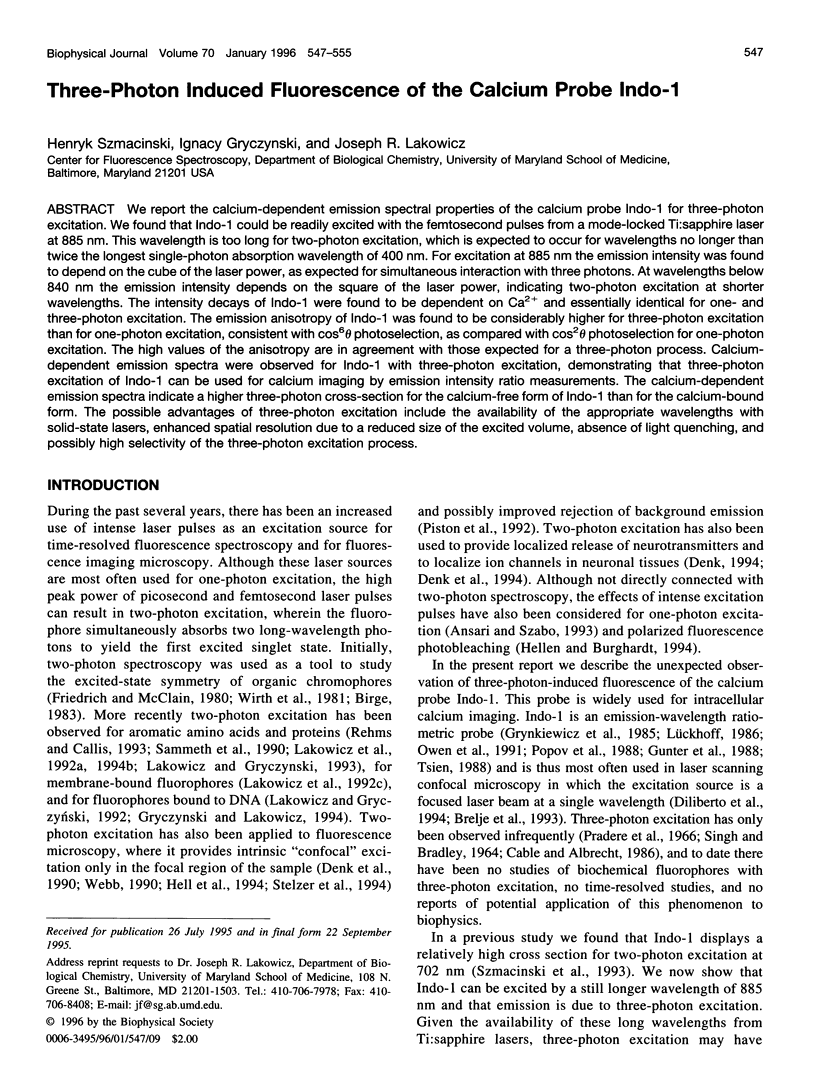
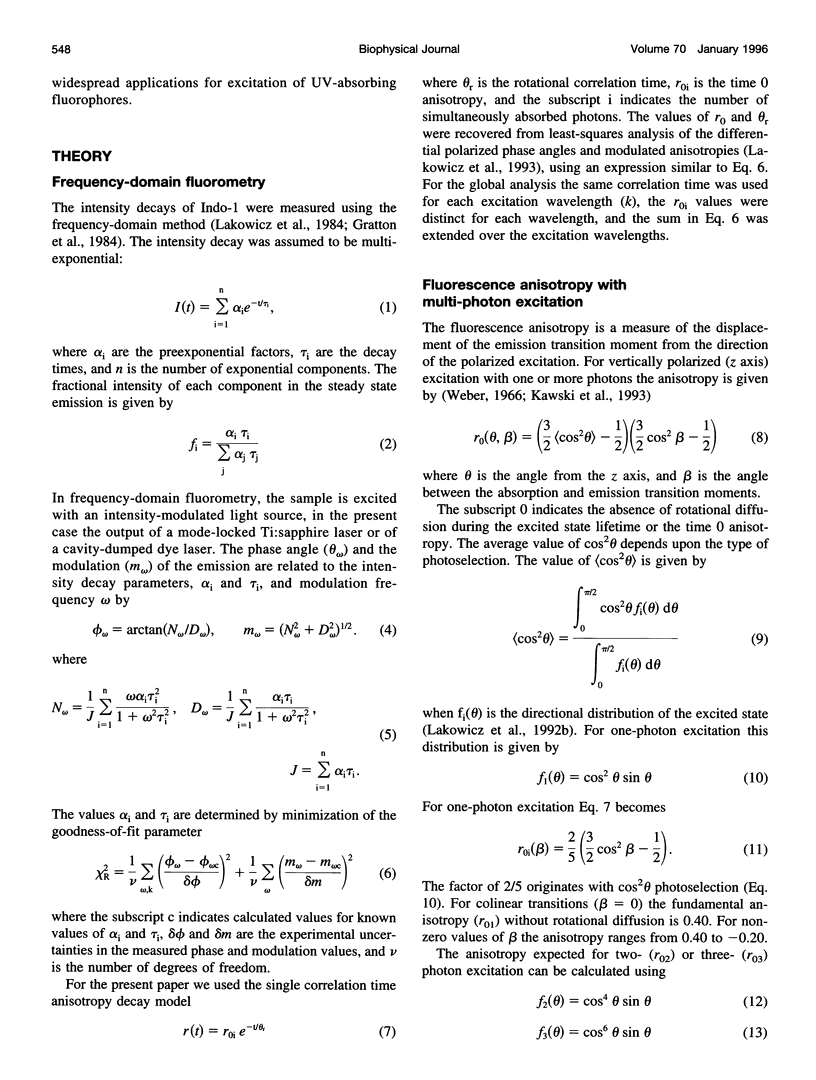
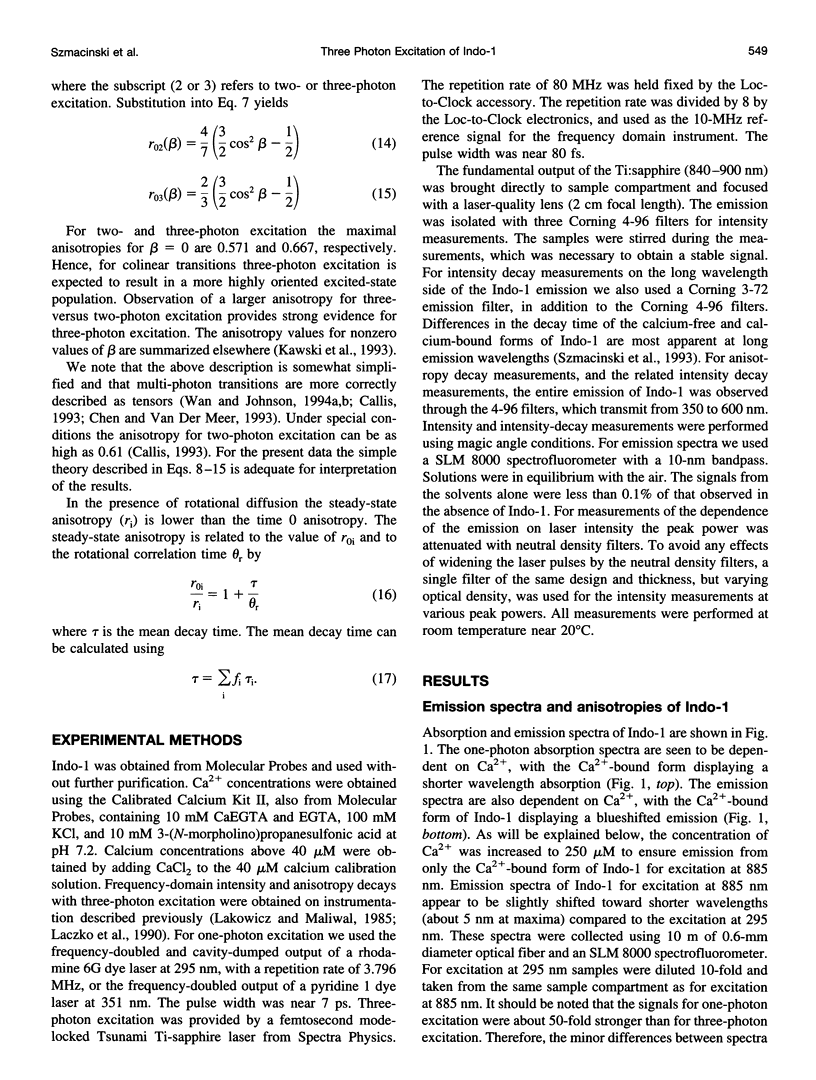

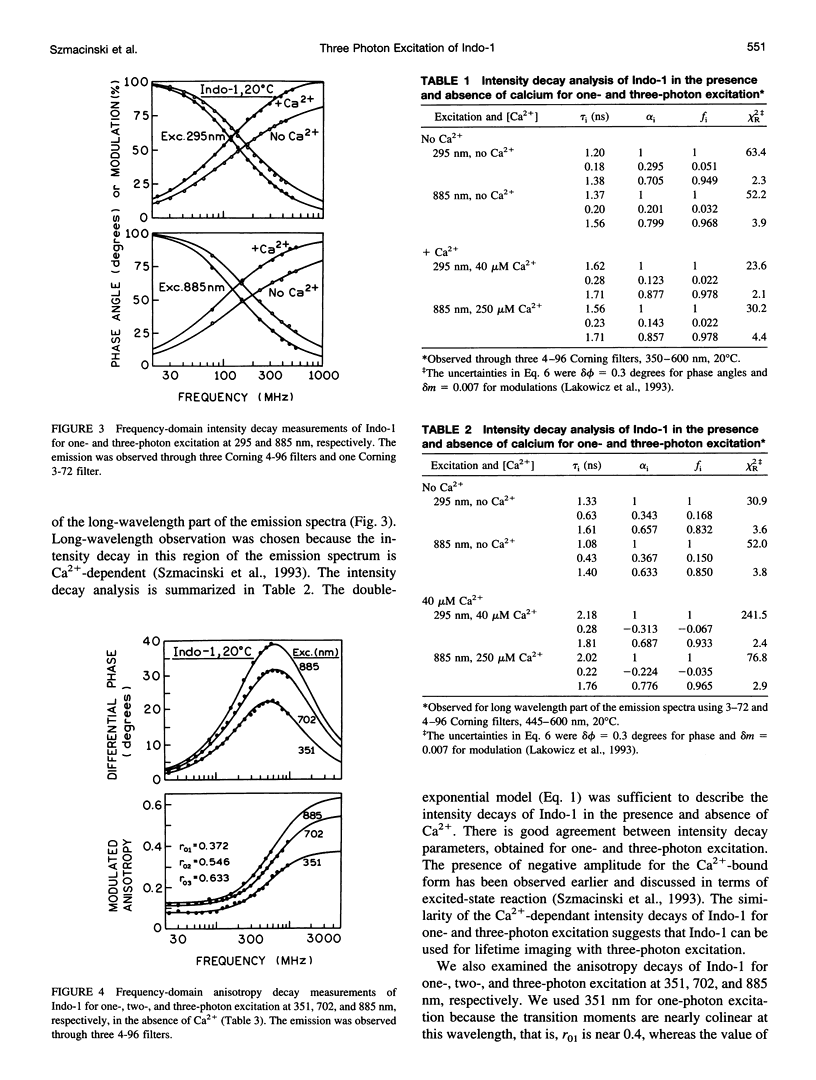
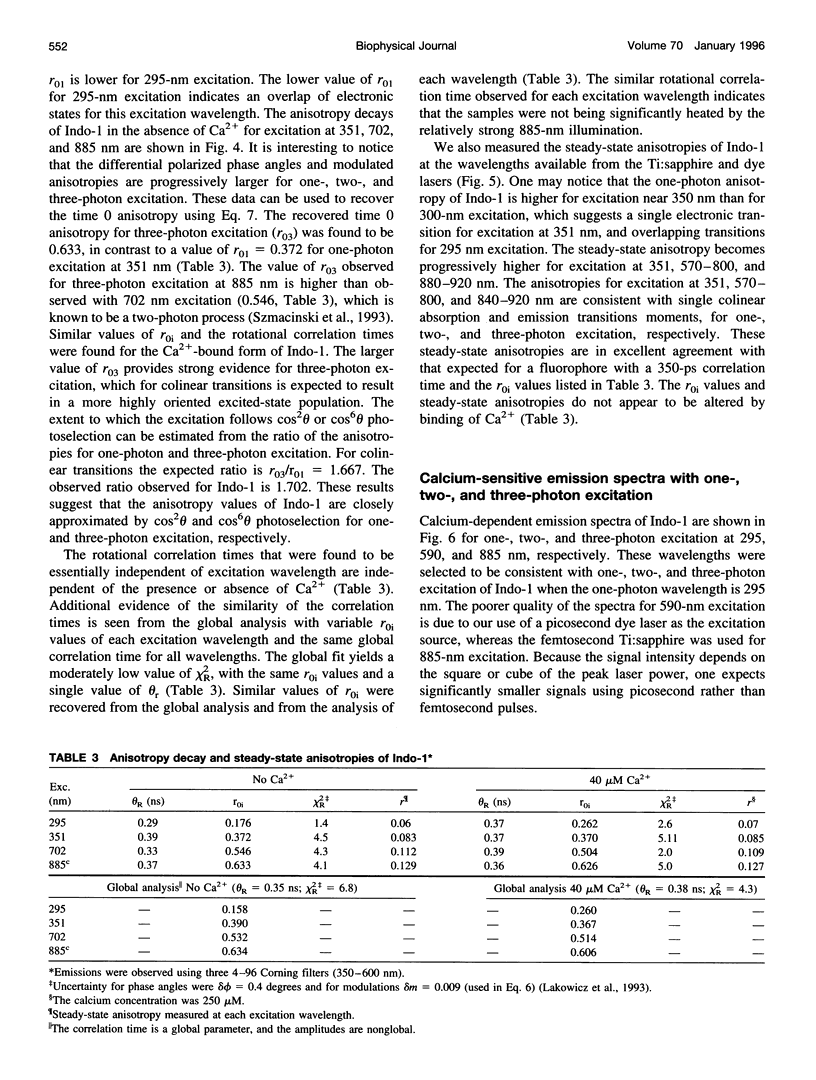
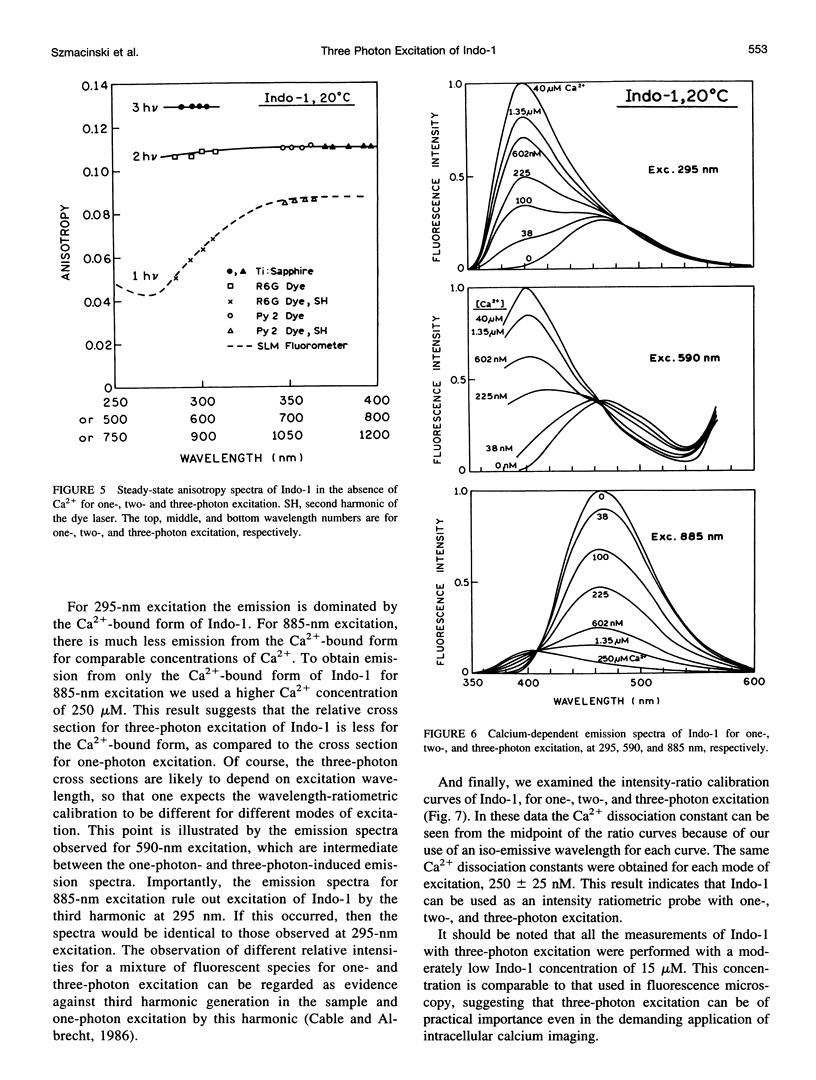

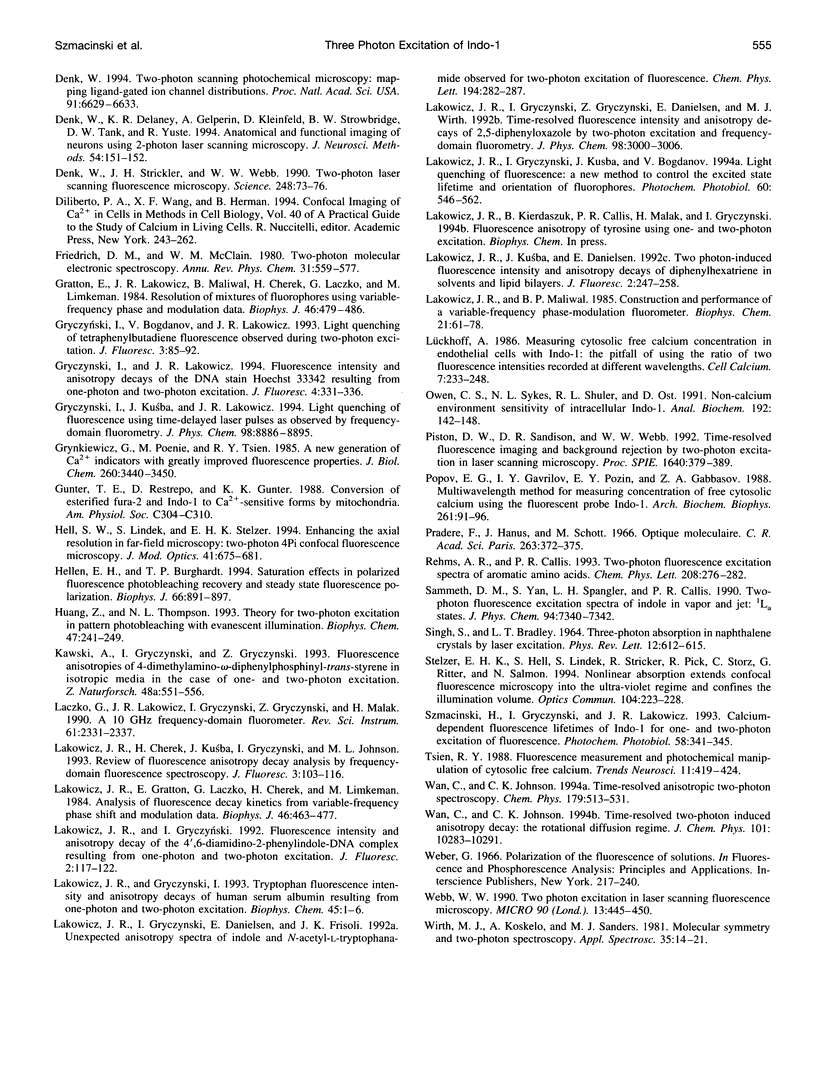
Selected References
These references are in PubMed. This may not be the complete list of references from this article.
- Ansari A., Szabo A. Theory of photoselection by intense light pulses. Influence of reorientational dynamics and chemical kinetics on absorbance measurements. Biophys J. 1993 Mar;64(3):838–851. doi: 10.1016/S0006-3495(93)81445-0. [DOI] [PMC free article] [PubMed] [Google Scholar]
- Brelje T. C., Wessendorf M. W., Sorenson R. L. Multicolor laser scanning confocal immunofluorescence microscopy: practical application and limitations. Methods Cell Biol. 1993;38:97–181. doi: 10.1016/s0091-679x(08)61001-8. [DOI] [PubMed] [Google Scholar]
- Chen S. Y., Van Der Meer B. W. Theory of two-photon induced fluorescence anisotropy decay in membranes. Biophys J. 1993 May;64(5):1567–1575. doi: 10.1016/S0006-3495(93)81526-1. [DOI] [PMC free article] [PubMed] [Google Scholar]
- Denk W., Delaney K. R., Gelperin A., Kleinfeld D., Strowbridge B. W., Tank D. W., Yuste R. Anatomical and functional imaging of neurons using 2-photon laser scanning microscopy. J Neurosci Methods. 1994 Oct;54(2):151–162. doi: 10.1016/0165-0270(94)90189-9. [DOI] [PubMed] [Google Scholar]
- Denk W., Strickler J. H., Webb W. W. Two-photon laser scanning fluorescence microscopy. Science. 1990 Apr 6;248(4951):73–76. doi: 10.1126/science.2321027. [DOI] [PubMed] [Google Scholar]
- Denk W. Two-photon scanning photochemical microscopy: mapping ligand-gated ion channel distributions. Proc Natl Acad Sci U S A. 1994 Jul 5;91(14):6629–6633. doi: 10.1073/pnas.91.14.6629. [DOI] [PMC free article] [PubMed] [Google Scholar]
- Diliberto P. A., Wang X. F., Herman B. Confocal imaging of Ca2+ in cells. Methods Cell Biol. 1994;40:243–262. doi: 10.1016/s0091-679x(08)61117-6. [DOI] [PubMed] [Google Scholar]
- Gratton E., Limkeman M., Lakowicz J. R., Maliwal B. P., Cherek H., Laczko G. Resolution of mixtures of fluorophores using variable-frequency phase and modulation data. Biophys J. 1984 Oct;46(4):479–486. doi: 10.1016/S0006-3495(84)84044-8. [DOI] [PMC free article] [PubMed] [Google Scholar]
- Grynkiewicz G., Poenie M., Tsien R. Y. A new generation of Ca2+ indicators with greatly improved fluorescence properties. J Biol Chem. 1985 Mar 25;260(6):3440–3450. [PubMed] [Google Scholar]
- Gunter T. E., Restrepo D., Gunter K. K. Conversion of esterified fura-2 and indo-1 to Ca2+-sensitive forms by mitochondria. Am J Physiol. 1988 Sep;255(3 Pt 1):C304–C310. doi: 10.1152/ajpcell.1988.255.3.C304. [DOI] [PubMed] [Google Scholar]
- Hellen E. H., Burghardt T. P. Saturation effects in polarized fluorescence photobleaching recovery and steady state fluorescence polarization. Biophys J. 1994 Mar;66(3 Pt 1):891–897. doi: 10.1016/s0006-3495(94)80865-3. [DOI] [PMC free article] [PubMed] [Google Scholar]
- Huang Z., Thompson N. L. Theory for two-photon excitation in pattern photobleaching with evanescent illumination. Biophys Chem. 1993 Oct;47(3):241–249. doi: 10.1016/0301-4622(93)80049-o. [DOI] [PubMed] [Google Scholar]
- Lakowicz J. R., Gryczynski I. Tryptophan fluorescence intensity and anisotropy decays of human serum albumin resulting from one-photon and two-photon excitation. Biophys Chem. 1992 Nov;45(1):1–6. doi: 10.1016/0301-4622(92)87017-d. [DOI] [PubMed] [Google Scholar]
- Lakowicz J. R., Gryczyński I., Kuśba J., Bogdanov V. Light quenching of fluorescence: a new method to control the excited state lifetime and orientation of fluorophores. Photochem Photobiol. 1994 Dec;60(6):546–562. doi: 10.1111/j.1751-1097.1994.tb05147.x. [DOI] [PubMed] [Google Scholar]
- Lakowicz J. R., Laczko G., Cherek H., Gratton E., Limkeman M. Analysis of fluorescence decay kinetics from variable-frequency phase shift and modulation data. Biophys J. 1984 Oct;46(4):463–477. doi: 10.1016/S0006-3495(84)84043-6. [DOI] [PMC free article] [PubMed] [Google Scholar]
- Lakowicz J. R., Maliwal B. P. Construction and performance of a variable-frequency phase-modulation fluorometer. Biophys Chem. 1985 Jan;21(1):61–78. doi: 10.1016/0301-4622(85)85007-9. [DOI] [PubMed] [Google Scholar]
- Lückhoff A. Measuring cytosolic free calcium concentration in endothelial cells with indo-1: the pitfall of using the ratio of two fluorescence intensities recorded at different wavelengths. Cell Calcium. 1986 Aug;7(4):233–248. doi: 10.1016/0143-4160(86)90003-5. [DOI] [PubMed] [Google Scholar]
- Owen C. S., Sykes N. L., Shuler R. L., Ost D. Non-calcium environmental sensitivity of intracellular Indo-1. Anal Biochem. 1991 Jan;192(1):142–148. doi: 10.1016/0003-2697(91)90199-4. [DOI] [PubMed] [Google Scholar]
- Popov E. G., Gavrilov Y. Iu, Pozin EYa, Gabbasov Z. A. Multiwavelength method for measuring concentration of free cytosolic calcium using the fluorescent probe indo-1. Arch Biochem Biophys. 1988 Feb 15;261(1):91–96. doi: 10.1016/0003-9861(88)90107-5. [DOI] [PubMed] [Google Scholar]
- Szmacinski H., Gryczynski I., Lakowicz J. R. Calcium-dependent fluorescence lifetimes of Indo-1 for one- and two-photon excitation of fluorescence. Photochem Photobiol. 1993 Sep;58(3):341–345. doi: 10.1111/j.1751-1097.1993.tb09571.x. [DOI] [PubMed] [Google Scholar]
- Tsien R. Y. Fluorescence measurement and photochemical manipulation of cytosolic free calcium. Trends Neurosci. 1988 Oct;11(10):419–424. doi: 10.1016/0166-2236(88)90192-0. [DOI] [PubMed] [Google Scholar]


